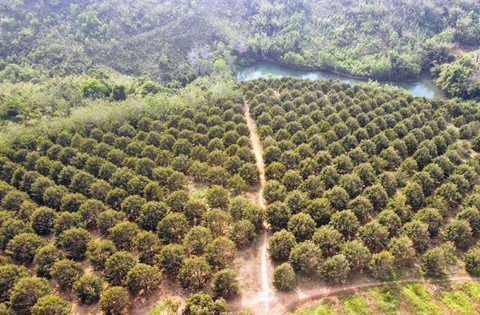
A durian farm in the central highland province of Đak Nông. — VNA/VNS Photo
Vietnamese durian has been taking China by storm, capturing nearly 32 per cent of the world’s largest market since entering in 2022, according to the Department of Plant Protection, under the Ministry of Agriculture and Rural Development (MARD).
Meeting the phytosanitary requirements to enter China has created an unprecedented opportunity to develop Việt Nam’s durian industry, steering it to higher standards of modernity, quality, safety and sustainability.
The department said exporters must continue improving their products and sales techniques to strengthen their foothold to compete against Thai durian, their main competition with up to 68 per cent market share in China.
As Vietnamese durian gained popularity in China, farmers have been switching to growing durian, getting rid of less productive crops in the process.
To date, the General Administration of Customs of China (GACC) has approved 708 area codes for durian cultivation and 168 facility codes for durian packaging in Việt Nam. The department said it must be made a top priority to ensure the codes’ integrity.
Local government and central agencies must step up efforts in the inspection, supervision and monitoring of cultivation areas, as well as packaging facilities to control the quality of exported durian from the growing stages to harvest, packaging and exporting. Violations and frauds must be dealt with severely and quickly.
However, long-term reforms that aim for a sustainable industry must still be rolled out, especially in building up a foundation for farmers and businesses to work together on the principle of equal partners and towards mutual benefits.
At the same time, Việt Nam should focus on the development of production and processing centres, as well as a product value chain. Currently, durian-growing area nationwide was reported at over 112,000 hectares, 9 per cent of the country’s fruit-growing area, with a production volume of 863,000 tonnes per year.
The main markets for Vietnamese durian are China, Thailand, Japan and the United States.
Last year, the Southeast Asian country exported over 603,000 tonnes of durian, of which more than 595,000 tonnes, or 98.6 per cent, were exported to China. By the end of February this year, Việt Nam exported over 41,000 tonnes to China. — VNS